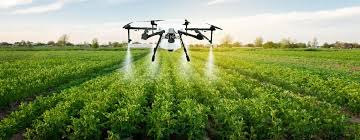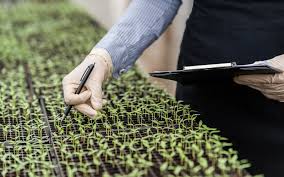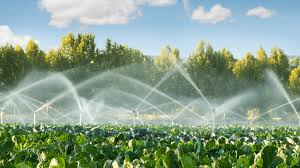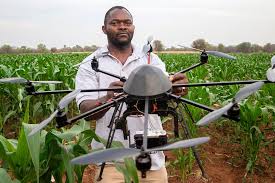Innovations in agriculture are transforming the way we produce food, making it possible to meet the demands of a rapidly growing global population. With the world population expected to reach nearly 10 billion by 2050, agriculture faces the immense challenge of increasing food production by about 60%.
This task is further complicated by climate change, resource scarcity, and soil degradation, which threaten traditional farming practices. To tackle these issues, the agricultural sector is turning to cutting-edge technologies and sustainable practices that boost productivity, conserve resources, and enhance resilience.
Precision agriculture is one of the most impactful innovations in modern farming. By utilizing technologies like GPS, Internet of Things (IoT), and data analytics, farmers can monitor soil health, crop conditions, and weather patterns in real time, allowing them to make informed decisions that reduce waste and maximize yield.
Similarly, biotechnology is making significant strides, offering genetically modified crops designed to resist pests, diseases, and harsh environmental conditions. These crops not only yield more but also reduce the need for chemical inputs, supporting a more sustainable agricultural system.
Emerging practices like vertical farming and hydroponics are also changing how and where food can be grown. These methods make it possible to grow food in urban areas, using less land and water than traditional farming requires.
Additionally, robotics and automation are enhancing efficiency by handling tasks such as planting, harvesting, and sorting, which reduces labor demands and increases productivity.
Through these and other innovations, agriculture is becoming more efficient, sustainable, and capable of meeting the food needs of future generations. By integrating advanced technologies, the agricultural sector is building a foundation for resilient and productive food systems that will ensure food security in the years to come.
The Challenge of Feeding a Growing Population
Feeding a growing population is a complex challenge influenced by various factors.
1. Increased Demand for Food: The rising global population results in increased demand for food. This necessitates a significant enhancement in food production, requiring innovative farming techniques, better crop varieties, and efficient resource management to meet this demand without overexploiting natural resources.
2. Resource Constraints: Limited access to essential resources such as water and arable land presents a significant challenge. Water scarcity is exacerbated by climate change, leading to droughts in many regions. Sustainable practices, such as rainwater harvesting and efficient irrigation, are essential to mitigate these constraints.
3. Nutritional Needs: With an increasing population, the nutritional quality of food is as important as the quantity produced. There is a pressing need for diverse food systems that provide essential vitamins and minerals to combat malnutrition, particularly in developing countries where food insecurity is prevalent.
4. Economic Factors: Economic instability in many regions impacts food access, affordability, and availability. Food systems must be resilient to market fluctuations, ensuring that all populations can access sufficient, safe, and nutritious food.
5. Global Supply Chains: The COVID-19 pandemic highlighted vulnerabilities in global food supply chains. Disruptions can lead to food shortages and price spikes, emphasizing the importance of local food systems and reducing reliance on long-distance transportation.
Precision Agriculture

Precision agriculture utilizes advanced technologies to improve farming efficiency and productivity.
1. Data-Driven Decision Making: Technologies like GPS, drones, and sensors allow farmers to collect and analyze data on soil conditions, weather patterns, and crop health. This information helps them make informed decisions regarding planting schedules, irrigation needs, and pest management strategies.
2. Resource Optimization: Precision agriculture minimizes input waste by applying water, fertilizers, and pesticides only where and when needed. This targeted approach not only reduces costs for farmers but also decreases environmental impact, such as runoff that can harm nearby ecosystems.
3. Yield Monitoring: Farmers can track crop performance throughout the growing season, identifying underperforming areas and adjusting management practices accordingly. This proactive approach enables timely interventions that can significantly enhance overall yields.
4. Cost Efficiency: By optimizing resource use and improving crop performance, precision agriculture can lower production costs, making farming more economically viable and sustainable in the long run.
5. Sustainability: Implementing precision agriculture practices contributes to sustainable farming by promoting efficient resource use, reducing greenhouse gas emissions, and protecting biodiversity.
Sustainable Farming Practices
Sustainable farming practices focus on long-term ecological balance and resource conservation.
1. Crop Rotation: This technique involves alternating different crops in the same field over seasons. Crop rotation enhances soil fertility, reduces pest and disease buildup, and promotes a healthier ecosystem, leading to improved crop yields.
2. Organic Farming: Emphasizing natural inputs and practices, organic farming avoids synthetic chemicals, promoting biodiversity and healthier ecosystems. Organic farming not only reduces chemical residues in food but also fosters better soil health and resilience.
3. Agroforestry: Integrating trees and shrubs into farming systems provides numerous benefits, such as improved soil health, enhanced biodiversity, and additional income streams through timber and non-timber forest products. Agroforestry systems also contribute to carbon sequestration, helping mitigate climate change.
4. Conservation Tillage: This practice involves minimal soil disturbance during planting, preserving soil structure and organic matter. Conservation tillage reduces erosion, improves water retention, and enhances soil health, leading to better crop yields over time.
5. Water Management: Efficient irrigation systems, such as drip or sprinkler irrigation, help conserve water while ensuring crops receive adequate moisture. Implementing practices like rainwater harvesting can further enhance water availability, especially in arid regions.
Read Also: Squash Leaves: Economic Importance, Uses, and By-Products
Biotechnology in Agriculture

Biotechnology offers innovative solutions to enhance agricultural productivity and resilience to environmental challenges.
1. Genetically Modified Organisms (GMOs): GMOs can be engineered to exhibit beneficial traits such as pest resistance, herbicide tolerance, and drought tolerance. By reducing crop losses and improving yields, GMOs play a significant role in ensuring food security.
2. Disease Resistance: Biotechnology enables the development of crops that can withstand diseases caused by pathogens, thus reducing the need for chemical pesticides. This not only lowers production costs for farmers but also minimizes chemical runoff into the environment.
3. Nutritional Enhancement: Biofortification aims to increase the nutritional value of staple crops, addressing deficiencies in essential vitamins and minerals. For example, Golden Rice is genetically engineered to produce beta-carotene, a precursor to vitamin A, helping combat malnutrition in regions reliant on rice as a staple food.
4. Reduced Environmental Impact: By improving resource use efficiency and reducing chemical inputs, biotechnology contributes to more sustainable agricultural practices. For instance, crops engineered for improved nitrogen use can reduce fertilizer applications, lowering environmental impact.
5. Research and Innovation: Ongoing advancements in agricultural biotechnology, such as CRISPR gene editing, hold the potential to revolutionize crop breeding and enhance resilience to climate change, pests, and diseases.
Vertical Farming and Urban Agriculture
Vertical farming and urban agriculture present innovative solutions to food production in densely populated areas.
1. Space Efficiency: Vertical farming utilizes stacked layers to grow crops, significantly maximizing land use in urban areas where space is limited. By employing vertical systems, urban environments can produce more food per square meter than traditional farming.
2. Local Food Production: Urban agriculture reduces transportation costs and emissions by producing food closer to consumers. This approach not only increases food freshness but also fosters community engagement and local economies.
3. Resource Conservation: Vertical farms often utilize hydroponic or aeroponic systems, which use significantly less water than traditional farming methods. These systems recirculate water, minimizing waste and promoting sustainability in urban settings.
4. Technology Integration: Vertical farms leverage advanced technologies such as LED lighting, climate control systems, and automated monitoring to optimize growth conditions, allowing year-round production of fresh produce.
5. Community Engagement: Urban agriculture initiatives can foster community involvement, promoting education about sustainable practices and healthy eating. These projects can also strengthen social ties and create a sense of community.
Drones and Aerial Technology
Drones and aerial technology are revolutionizing farming practices by providing real-time data and insights.
1. Crop Monitoring: Drones equipped with cameras and sensors can capture high-resolution images of crops, allowing farmers to monitor health, growth patterns, and overall field conditions. This helps in identifying areas needing attention, such as pest infestations or nutrient deficiencies.
2. Precision Spraying: Aerial technology enables targeted application of pesticides and fertilizers, reducing chemical use and minimizing environmental impact. Drones can efficiently cover large areas, ensuring that inputs are applied only where needed.
3. Soil Analysis: Drones can conduct aerial surveys to assess soil health and composition. This data assists in making informed decisions about crop selection and soil amendments.
4. Mapping and Planning: High-resolution aerial maps generated by drones help in planning planting patterns, irrigation systems, and land use, optimizing resource allocation.
5. Time and Cost Efficiency: By using drones, farmers can save time and labor costs associated with traditional monitoring and spraying methods, allowing for more efficient farm management.
Read Also : Mustard Seeds (Brassica nigra): Health Benefits, Facts, and Side Effects
Smart Irrigation Systems

Smart irrigation systems leverage technology to optimize water usage in agriculture, promoting sustainability.
1. Soil Moisture Sensors: These sensors measure the moisture level in the soil, allowing farmers to irrigate only when necessary. This prevents overwatering and conserves water resources.
2. Automated Scheduling: Smart irrigation systems can be programmed to operate based on weather forecasts and soil moisture data, ensuring that crops receive adequate water without waste.
3. Remote Monitoring: Farmers can monitor irrigation systems remotely through mobile apps, enabling them to make real-time adjustments and decisions based on current conditions.
4. Water Conservation: By applying water precisely when and where needed, smart irrigation contributes to significant water savings and enhances crop health.
5. Increased Crop Yields: Efficient water management leads to healthier plants and improved yields, making smart irrigation systems a vital tool for modern agriculture.
Data Analytics and Farm Management Software
Data analytics and farm management software empower farmers to make data-driven decisions for better outcomes.
1. Farm Data Collection: These software solutions facilitate the collection of data related to crop performance, weather conditions, and market trends, enabling comprehensive analysis.
2. Performance Analysis: By analyzing historical data, farmers can identify patterns, predict outcomes, and make informed decisions regarding crop rotation, planting schedules, and resource allocation.
3. Financial Management: Farm management software helps farmers track expenses, revenues, and profitability, enabling better financial planning and budgeting.
4. Supply Chain Management: Data analytics aids in optimizing supply chains, from production to distribution, ensuring that products reach the market efficiently.
5. Informed Decision Making: With access to real-time data and analytics, farmers can respond quickly to changes in market conditions or environmental factors, improving overall farm resilience.
Agroecology and Permaculture
Agroecology and permaculture are holistic approaches that emphasize sustainability and biodiversity in agriculture.
1. Agroecology: This approach integrates ecological principles into agricultural practices, promoting biodiversity, soil health, and ecosystem resilience. Agroecology focuses on local resources and knowledge, fostering sustainable farming systems that are adaptable to changing conditions.
2. Permaculture Design: Permaculture is a design system that mimics natural ecosystems to create sustainable and self-sufficient agricultural systems. It emphasizes diverse plantings, waste recycling, and efficient use of resources, creating synergistic relationships among plants, animals, and the environment.
3. Soil Health Improvement: Both agroecology and permaculture prioritize soil health through practices such as cover cropping, composting, and reduced tillage, which enhance soil fertility and structure.
4. Biodiversity Promotion: These practices encourage biodiversity by incorporating a variety of crops and animals, which can lead to more resilient systems that are less susceptible to pests and diseases.
5. Community Involvement: Agroecology and permaculture often involve local communities in the planning and management of agricultural systems, fostering a sense of ownership and stewardship over natural resources.
Addressing the challenge of feeding a growing population requires a multi-faceted approach that incorporates precision agriculture, sustainable practices, biotechnology, and innovative solutions like vertical farming.
By embracing these strategies, the agricultural sector can work towards ensuring food security and sustainability for future generations.
Innovations like drones, smart irrigation systems, and data analytics, combined with sustainable practices such as agroecology and permaculture, are shaping the future of agriculture. These technologies and approaches not only enhance productivity but also promote environmental sustainability and resilience, ensuring food security for generations to come.
Do you have any questions, suggestions, or contributions? If so, please feel free to use the comment box below to share your thoughts. We also encourage you to kindly share this information with others who might benefit from it. Since we can’t reach everyone at once, we truly appreciate your help in spreading the word. Thank you so much for your support and for sharing!
Read Also : Fly Ash Complete Management Guide

